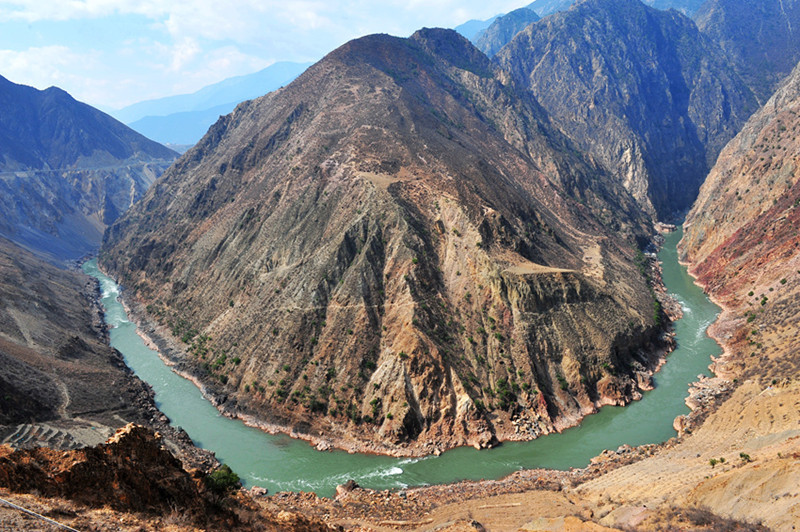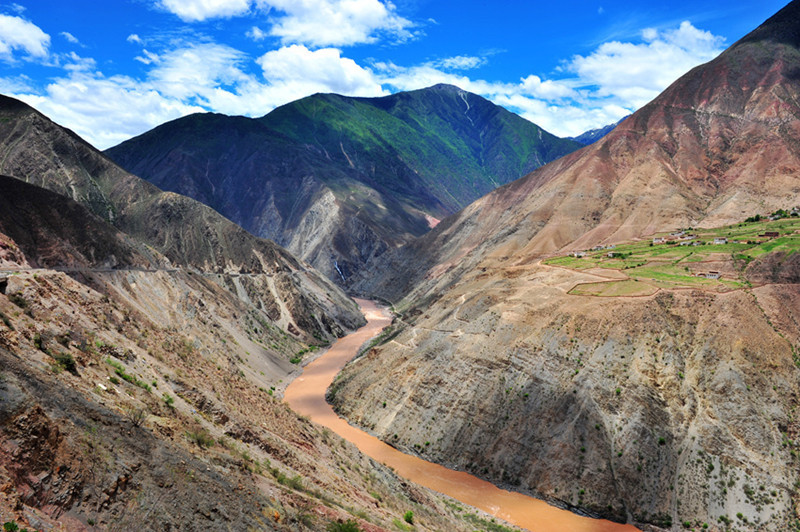Rafting Travel Guide of Lancang-Mekong River in Yunnan
The Lancang River (Lancang River) originates in the northeastern part of the Tanggula Mountains in Qinghai Province, China. It flows through Tibet and Yunnan provinces, and once it leaves China, it is called the Mekong River. The Mekong flows through Myanmar, Laos, Thailand, Cambodia, and finally into the South China Sea at Ho Chi Minh City in Vietnam. The total length of the main river is 4880 km, and the total catchment area is 81×10^4 km^2. In China, the main river length is 2161 km, with a catchment area of 167,487 km^2. To the west, it is separated from the Nu River by the Nu Mountains (the southern section is the Biluo Snow Mountains) and the Bangma Mountains, while to the east, it is separated from the Jinsha River and the Red River by the Yunling Mountains and the Wuliang Mountains. The Lancang River traverses the Hengduan Mountains and is one of the most typical north-south oriented rivers in the world.

The Lancang River Basin in Yunnan
The Lancang River flows through several cities in Yunnan, including Diqing, Nujiang, Dali, Baoshan, Lincang, Pu’er, and Xishuangbanna, making it the largest international river in Southeast Asia. The length of the Lancang River is 4880 km and it flows in a north-south direction.
The upstream topography of the Lancang River mainly includes river valley plains, high mountains, glaciers, high mountain-river valleys, and high mountain-canyons. The midstream topography is characterized by typical high mountain-canyon topography, while the downstream topography consists of medium-low mountains and basin bottoms.
The Lancang River basin experiences dry and cold monsoons in winter and wet and hot southwest monsoons in summer, resulting in a dry winter and a rainy summer. Spring and autumn are transitional periods between winter and summer, and are relatively short. Therefore, the Lancang River region can be divided into two seasons: the dry season and the rainy season.

Diqing
Rafting Route: From Benzilan to Tacheng
- Highlights: Scenic views of the Meili Snow Mountain, Tibetan culture, and pristine nature.
- Difficulty: Moderate to challenging, with Class III-IV rapids.
Nujiang
Rafting Route: From Bingzhongluo to Fugong
- Highlights: Deep gorges, lush forests, and Lisu ethnic villages.
- Difficulty: Moderate, with Class II-III rapids.
Dali
Rafting Route: From Shuanglang to Xiangyun
- Highlights: Erhai Lake views, Bai ethnic culture, and the Cangshan Mountain backdrop.
- Difficulty: Easy to moderate, with Class I-II rapids.
Baoshan
Rafting Route: From Tengchong to Longling
- Highlights: Hot springs, volcanic landscapes, and diverse flora and fauna.
- Difficulty: Moderate, with Class II-III rapids.
Lincang
Rafting Route: From Fengqing to Yunxian
- Highlights: Tea plantations, bamboo forests, and ethnic Dai villages.
- Difficulty: Moderate, with Class II-III rapids.
Pu’er
Rafting Route: From Ning’er to Simao
- Highlights: Dense tropical rainforests, wildlife sightings, and coffee plantations.
- Difficulty: Moderate to challenging, with Class III-IV rapids.
Xishuangbanna
Rafting Route: From Jinghong to Mengla
- Highlights: Tropical climate, Dai culture, and vibrant biodiversity.
- Difficulty: Moderate, with Class II-III rapids.
Lancang-Mekong River in Changning County, Baoshan
Rafting on the Lancang River in Xishuangbanna
The Lancang River originates from the Qinghai-Tibet Plateau, sharing its source with the Yangtze and Yellow Rivers. After exiting Xishuangbanna, it flows through Laos, Myanmar, Thailand, Cambodia, and Vietnam, where it is known as the Mekong River. The Lancang River’s rapid currents and lush vegetation along its banks create breathtaking scenery. Rafting here feels like navigating through paradise, enjoying a picturesque and exhilarating experience.
The Lancang River-Mekong River rafting route is 18 kilometers long. The starting pier is located under the “Water Splashing Festival” viewing platform in Jinghong City, and the endpoint pier is at the Akha Village. Along the way, you will pass by Monkey Mountain, home to various wild animals such as capped langurs and Assamese macaques. You can take a break midway to explore the thousand-year-old bamboo forest and dig for “treasures” in the sand. After enjoying tropical fruits and fragrant roasted rice wine prepared by the Dai people, you will continue your journey, eventually reaching the Akha Village. Here, you can discover the secrets of the ancient cottonwood descendants in the dense forest.

Three Reasons to Visit the Lancang River
Reason 1: Rafting on the Lancang River offers a poetic and picturesque adventure with stunning natural scenery and rich cultural landscapes, making it the perfect embodiment of Xishuangbanna’s beauty.
Reason 2: Rafting on the Lancang River allows you to interact with Dai girls bathing by the river, tropical rainforests, sandy beaches, rare birds and animals, and Dai bamboo houses, providing a uniquely charming experience.
Reason 3: Rafting on the Lancang River means navigating through lush mountains and clear waters, experiencing an adrenaline-pumping adventure!
Transportation
To reach Xishuangbanna from Kunming, you can purchase a ticket at the South Yao Bus Station (next to the Kunming South Railway Station). The ticket price is around 200 RMB, and the journey takes approximately 7-8 hours via the expressway. Alternatively, you can choose to take an overnight bus, which is cheaper than the daytime option.
Lancang-Mekong River Raftinng Tour Inclusions
- Transportation: Shuttle services from the meeting point to the rafting starting point and back.
- Meals: All meals during the trip, including packed lunches and dinners.
- Equipment: Rafting gear (rafts, paddles, life jackets, helmets), camping gear (tents, sleeping bags, mats), and safety equipment (ropes, first aid kits).
- Guides: Professional rafting guides with local knowledge and first aid training.
- Insurance: Comprehensive travel insurance covering accidents and emergencies.
Lancang-Mekong River Raftinng Tour Personal Gear
- Quick-dry clothing (long sleeves and pants)
- Change of clothes for after rafting
- Water shoes or hiking shoes
- Personal snacks and water bottle
- Sunscreen and insect repellent
- Headlamp or flashlight
- Power bank for electronic devices
- Personal medications
Travel Tips
- Best Time to Go: The ideal time for rafting on the Lancang River is from May to October, when the water levels are suitable, and the weather is warm.
- Fitness Level: Participants should have a moderate level of fitness and be comfortable with water activities.
- Cultural Sensitivity: Respect local customs and traditions, especially when visiting ethnic villages.
Safety Notes
- Always wear a life jacket and helmet while on the water.
- Follow the guide’s instructions at all times.
- Be aware of weather conditions and river levels.
- Do not raft if you have heart conditions, severe asthma, or are pregnant.


















